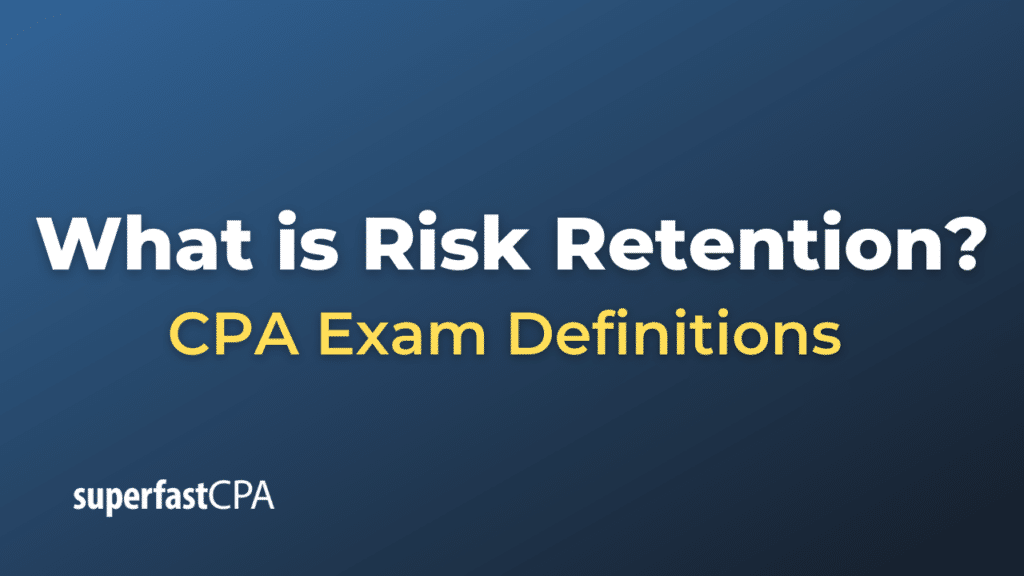Risk Retention
Risk retention refers to the decision by an individual, organization, or entity to assume and self-manage a particular risk rather than transferring it to another party, such as an insurance company. This approach is usually adopted when the cost of insuring against the risk is considered too high, when the probability of the risk materializing is deemed low, or when the organization believes it has the financial capacity and expertise to manage the potential consequences of the risk itself.
There are several forms or mechanisms through which risk retention can be practiced:
- Self-insurance: Larger companies, instead of purchasing insurance from carriers, might set aside a pool of funds to cover potential losses. This approach can offer cost savings over time if claims are lower than premiums would have been.
- High Deductibles : A company might purchase insurance but opt for a high deductible, meaning they will pay out-of-pocket for smaller claims and rely on insurance for larger, more catastrophic events.
- Captive Insurance Companies: Some large corporations or groups of companies form their own insurance entities, known as captives, to insure their risks. Captives allow for more control over insurance costs and can offer tax benefits.
- Risk Retention Groups (RRGs): A liability insurance company created by its owner-customers, who are often businesses from the same industry. RRGs allow members to create a tailored insurance solution for risks common to their industry.
- Reserves: Financial reserves can be established by setting aside funds to address known or expected risks.
The decision to retain risk should be made after careful analysis of the potential consequences of the risk, the likelihood of the risk event occurring, the organization’s financial ability to absorb losses, and the cost and availability of transferring the risk. It is a fundamental aspect of risk management.
Risk retention is often contrasted with risk transfer, where the risk is shifted entirely or in part to another entity (e.g., through insurance or contractual agreements). The balance between risk retention and risk transfer is at the heart of many organizations’ risk management strategies.
Example of Risk Retention
Let’s use a hypothetical example to illustrate risk retention:
Scenario: MegaCorp, a large manufacturing company, is considering how to manage the risk of potential equipment breakdowns at its main factory.
Options:
- Purchase a comprehensive equipment breakdown insurance: This would cover all potential repair and replacement costs. The annual premium is $1 million.
- Retain the risk: Instead of purchasing insurance, MegaCorp could set aside a specific amount of money each year into a dedicated reserve fund to cover potential breakdown costs.
Analysis:
MegaCorp evaluates its equipment’s age, maintenance records, and the historical frequency and cost of breakdowns over the past decade. They find:
- The average annual breakdown cost has been $400,000.
- Significant breakdowns, costing more than $1 million, occurred only twice in the past decade.
- They expect that with new maintenance protocols, the frequency and severity of breakdowns can be further reduced.
Given this data, MegaCorp decides that instead of purchasing the insurance, they will retain the risk. They opt to:
- Set aside $600,000 annually into a dedicated reserve fund. This amount is more than the historical annual average to account for unforeseen issues.
- Invest in advanced maintenance and equipment monitoring to reduce the risk further.
Outcome:
Over several years, due to advanced maintenance protocols, the annual breakdown costs hover around $350,000. MegaCorp manages to handle these costs using the reserve fund, and by retaining the risk, they save money compared to the cost of the insurance premium.
However, they are also aware that in a year with a major breakdown, they might have costs exceeding their reserve. They are prepared for this, understanding it’s a calculated risk.
This example illustrates that risk retention can be a cost-effective strategy when potential risks are understood and managed. However, it’s crucial for companies to be aware of and prepared for the potential consequences, ensuring that retained risks don’t jeopardize the company’s financial stability or operational continuity.












